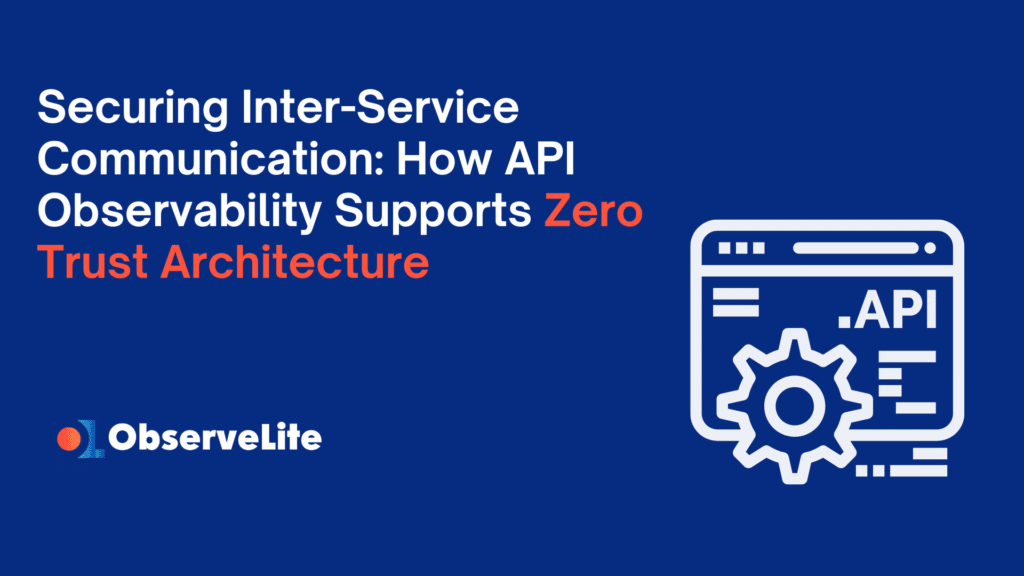As organizations increasingly adopt microservices, ensuring secure communication between services has become a top priority. Microservices architectures are dynamic and distributed, relying heavily on APIs for inter-service communication. While this design promotes scalability and flexibility, it also introduces new security risks. A breach in one service can cascade through the system, potentially compromising sensitive data or critical operations.
Zero Trust Architecture (ZTA) offers a robust framework to mitigate these risks by implementing a “never trust, always verify” approach. In this context, API observability becomes a critical enabler, providing the visibility and insights needed to secure communication across services in a Zero Trust environment.
Understanding Zero Trust Architecture
Zero Trust Architecture shifts away from traditional perimeter-based security models. Instead of assuming trust for anything inside the network, ZTA requires continuous verification of all users, devices, and interactions, regardless of their location. This model is especially effective for microservices, where interactions happen at multiple levels and across distributed systems.
Key principles of Zero Trust include:
- Verify Explicitly: Authenticate and authorize every access request, using as much context as possible, such as user identity, location, and device health.
- Use Least Privilege Access: Limit access permissions to the minimum necessary for performing tasks.
- Assume Breach: Design systems with the assumption that a breach has already occurred, minimizing lateral movement and impact.
Challenges in Securing Inter-Service Communication
In a microservices ecosystem, APIs act as the backbone of communication. However, this heavy reliance on APIs introduces several challenges:
- Dynamic and Distributed Services
Microservices are often hosted across different environments, such as on-premises data centers, public clouds, or hybrid setups. Ensuring secure communication between these services requires continuous monitoring and control. - Service-to-Service Authentication
Authenticating services to each other is more complex than user authentication. Misconfigurations can lead to unauthorized access or data leaks. - Lack of Visibility
Without full visibility into API traffic, it’s difficult to detect anomalies or vulnerabilities in real time. Blind spots can leave services vulnerable to exploitation. - Evolving Threats
APIs are a prime target for attackers. From injection attacks to unauthorized access, securing APIs against evolving threats is a constant challenge.
The Role of API Observability in Zero Trust
API observability provides the real-time visibility and contextual insights necessary to implement Zero Trust principles effectively. Here’s how:
- Real-Time Monitoring of API Traffic
Observability tools track API requests, responses, and interactions in real-time. This monitoring helps detect unusual patterns, such as unauthorized access attempts or excessive requests, which could indicate an attack. - Enforcing Authentication and Authorization
API observability ensures that authentication and authorization mechanisms are functioning as expected. By analyzing logs and traces, teams can verify that only authenticated services are communicating and that least privilege access is enforced. - Detailed Logging and Audit Trails
Observability tools create comprehensive logs of API interactions, enabling teams to trace any suspicious activity. This data is invaluable for forensic analysis and ensures compliance with security standards. - Early Threat Detection
By identifying anomalies in API behavior, observability tools can flag potential threats before they escalate. For example, detecting repeated failed requests or unexpected data transfers can help teams take proactive action. - Minimizing Lateral Movement
Observability provides insights into how services interact with each other, helping identify and limit unnecessary communication pathways. This reduces the risk of attackers moving laterally across the system. - Improved Security Posture
With observability, organizations gain a clear understanding of their API ecosystem, enabling them to continuously refine security policies and stay ahead of emerging threats.
ObserveLite: Empowering Zero Trust with API Observability
At ObserveLite, we understand the critical role observability plays in securing microservices. Our platform is designed to provide the deep visibility and actionable insights necessary to support Zero Trust principles.
Here’s how ObserveLite can help:
- Comprehensive Traffic Analysis: Monitor API traffic across all services, regardless of their location, for real-time threat detection.
- Seamless Integration: Integrate observability with your existing authentication and authorization systems to ensure a unified security approach.
- Actionable Insights: Leverage detailed metrics, logs, and traces to identify vulnerabilities and enforce Zero Trust principles effectively.
- Dynamic Adaptability: Our platform scales with your architecture, ensuring consistent observability as your microservices grow.
Best Practices for Securing Inter-Service Communication with Observability
- Adopt a Layered Security Approach
Combine API observability with other security measures, such as encryption, firewalls, and endpoint security, for a multi-faceted defense. - Continuously Monitor and Analyze
Regularly review observability data to identify trends, vulnerabilities, or potential weaknesses in your system. - Automate Threat Detection
Use automated alerts and responses to address potential threats quickly, minimizing the impact on operations. - Regularly Update Security Policies
As your architecture evolves, revisit and refine your security policies to align with new challenges and technologies. - Collaborate Across Teams
Foster collaboration between development, security, and operations teams to ensure a cohesive and proactive approach to securing inter-service communication.
Conclusion
Securing inter-service communication in a microservices architecture is no small feat, but it’s critical for maintaining a robust and resilient system. Zero Trust Architecture provides a strong framework for mitigating risks, and API observability is a vital component of its implementation.
By providing real-time insights, detailed audit trails, and proactive threat detection, API observability enables organizations to enforce Zero Trust principles effectively. At ObserveLite, we’re committed to helping organizations build secure and scalable systems by making observability a seamless part of their strategy.
Ready to enhance your security posture? Contact ObserveLite to learn how our observability solutions can support your Zero Trust goals and help you secure your microservices ecosystem.


